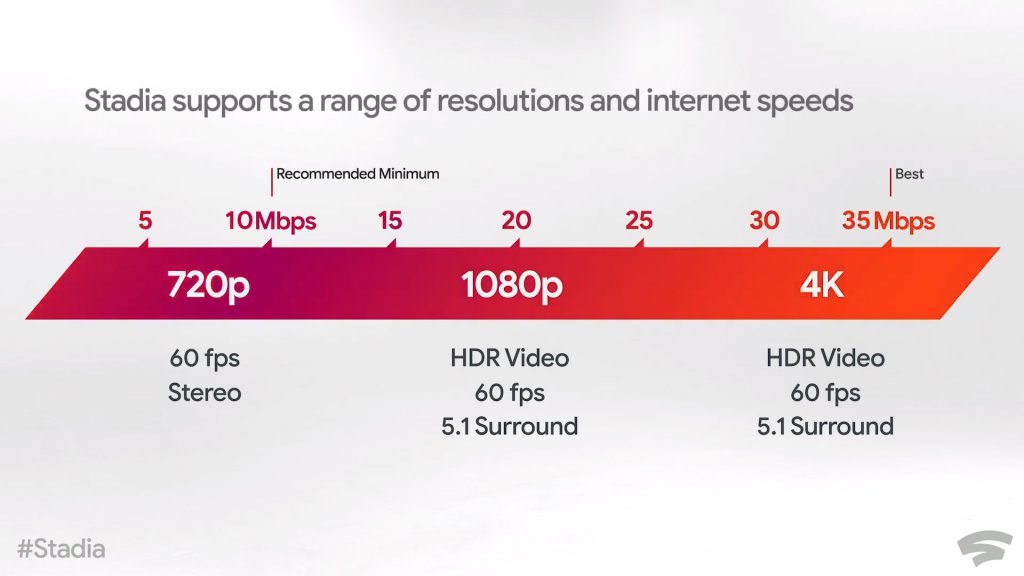TL;DR: Beamr CABR operating with the Intel Media SDK hardware encoder powered by Intel GPUs is the perfect video encoding engine for cloud gaming services like Google Stadia. The Intel GPU hardware encoder reaches real-time performance with a power envelope that is 90% less than a CPU based software solution. When combined with Beamr CABR (Content-Adaptive Bitrate) technology, the required bandwidth for cloud gaming is reduced by as much as 49% while delivering higher quality 65% of the time. Using the Intel hardware encoder combined with Beamr CABR enables players to enjoy a gaming experience that is competitive to a console and able to be streamed by cloud gaming platforms. Get more information about how CABR works.
The era of cloud gaming.
With the launch of Google Stadia, we have entered a new era in the games industry called cloud gaming. Just as streaming video services opened media and entertainment content to a broader audience by freeing it from the fixed frameworks of terrestrial (over-the-air), cable, and satellite distribution, so to will cloud gaming open gameplay to a larger audience. Besides extending gameplay to virtually anywhere the user has a network-connected device, the ability for a player to access an extensive library of games without needing to use a specific piece of hardware will push 25.9 million players to cloud gaming platforms by 2023, according to the media research group Kagan.
In addition to opening up gameplay to an “anywhere/anytime” experience. A major user experience benefit of cloud gaming is that players will not necessarily need to purchase a game, but in many cases will be free to access a vast library of their choosing instantaneously. Cloud gaming services promise the quality of a console or PC experience, but without the need to own expensive hardware and the configuration and software installation work that comes with that.
The one constraint that could cause cloud gaming to never catch up with the console experience.
With the wholesale transition of video entertainment content from traditional broadcast and physical media to streaming distribution, it is not hard to project the same pattern will occur for games. Except now, unlike the early days of video streaming where a 3Mbps home Internet connection was “high speed,” and the number of devices able to decode and reliably play back H.264 video was limited, even the lowest cost smartphone can stream video with acceptable quality.
Yet, there is a fundamental constraint that must be overcome for cloud gaming to reach its full market potential, and that is the bandwidth required to deliver a competitive video experience at 1080p60 or 4kp60 resolution. To better understand the bandwidth squeeze that is unique to cloud gaming, let’s examine the data and signal flow.
In FIGURE 1 we see the cloud gaming architecture moves compute-intensive operations, like the graphics rendering engine, to the cloud.

Shifting the compute-intensive function to the cloud eliminates device technical capability from being a bottleneck. However, as a result of the video rendering and encoding function not being local to the user, it means the video stream needs to be delivered over the network, with latency in the tens of milliseconds. And, at a framerate that is double the entertainment video frame rate of 24, 25, or 30 frames per second. Additionally, video game resolutions need to be HD with 4K preferable. Also, HDR is an increasingly important capability for many AAA game titles.
None of these requirements are impossible to meet, except as a result of needing fast encoding speed, the encoder must be operated in a mode that makes it difficult to produce high-quality and with small stream size. Because of the added time needed for the encoder to create B frames, and without the benefit of a look-ahead buffer, producing high quality with low bitrate is not possible. Hence why cloud gaming services require a significantly higher bitrate than what is possible with traditional video on demand streaming video services.
Beamr has been innovating in the area of performance, allowing us to encode H.264 and HEVC in software with breathtaking speed, even when running our most advanced Content-Adaptive Bitrate (CABR) rate-control. For video applications where a single encoder can serve hundreds of thousands or even millions of users, the compute requirement to do this in software, given the tremendous benefits of lower bitrate and higher quality, makes it easy to justify. But, in an application like cloud gaming, where the video encoder is matched 1:1 to every user, the computing cost to do this in software makes it uneconomical. The answer is to use a hardware encoder controlled by software, and running a content-adaptive optimization process which can deliver the additional bitrate savings needed.
FIGURE 2 illustrates the required Google Stadia bitrates.

The answer is to leverage hardware and software.
The Intel Media SDK and GPU engines occupy a well-established position in the market, with many video services relying on its included HEVC hardware encoder for real-time encoding. However, using the VBR rate-control only, there is a limit to the quality available when bitrate efficiency is essential. The advantage of Beamr’s next-generation rate-control technology, CABR (Content-Adaptive Bitrate), combined with Intel GPUs, is the secret to delivering bitrate efficiency and quality, in real-time, with 90% less power than software alone.
In verified testing, Beamr has shown that the Intel Media SDK hardware encoder controlled by CABR will produce the same perceptual quality as VBR encodes, with a confidence level greater than 95%. Using CABR gives a meaningful impact on user experience. 65% of the time, the player will perceive better quality at the same bandwidth, even while the gaming platform experiences up to a 49% reduction in the bandwidth required to provide the same quality level.
Watch Beamr Founder Sharon Carmel present Beamr CABR integrated with Intel Gen 11 hardware encoder at Intel Experience Day October 29, 2019 in Moscow.
Proof of performance.
As an image science company, Beamr is committed to proof of performance with all claims. For this reason, the industry recognizes that all technology, products, and solutions which carry the Beamr name, represent the pinnacle of quality. For this reason, it was insufficient to integrate CABR with the Intel Media SDK without being able to prove that the original quality of the stream is always preserved and that the user experience is improved. Testing comprised corresponding 10-second segments extracted from clips created with the Intel hardware encoder using VBR, and clips encoded using the Intel hardware encoder but with the integrated Beamr CABR rate-control.
The only way to test perceptual quality is with subjective techniques. We used a process similar to forced-choice double stimulus (FCDS), and closely approximating the ITU BT.500 method. Using the Beamr Auto-VISTA framework, we recruited anonymous viewers from Amazon Mechanical Turk where each viewer was shown corresponding segment pairs and asked to select which video had lower quality. The VBR and CABR encoded files were placed at random on the left and right sides. Validation pairs were used to verify the user’s capabilities with visible artifacts inserted, and only test results for users who correctly answered all four validation pairs were incorporated into the analysis. The viewers had up to five attempts to view the pairs before making a decision. Each viewer watched 20 segment pairs consisting of sixteen actual CABR, and VBR encodes, and four validation pairs.
Games used for testing were: CSGO, Fallout, and GTA5. To reflect realistic bitrates, we only tested the middle four bitrates out of the six bitrates provided. This was because the bitrate for the top layer was very high, and the bottom layer quality was very low. The four bitrates tested were spaced one JND (just noticeable difference) apart. Each target test pair was viewed 13 to 21 times by valid users, with a total of 800 target pair viewings, or about 17 viewings per pair on average. The total number of valid test sessions were 50, completed by more than 40 unique viewers.
Peeling back the data, you will notice that the per-pair statistical distribution is quite symmetrical above and below 50%. With the sampling base, this phenomenon is no surprise; human perception varies. The overall results had 800 views of 48 pairs, which make the statistical certainty higher, indicating that CABR is not compromising perceptual quality.
FIGURE 4 shows CABR encodes had the same perceptual quality as VBR and with a confidence level of more than 95%.

Better quality, lower bitrate.
Beamr CABR encoded streams offer higher quality when compared subjectively to a VBR equivalent encode, while offering a bitrate savings of up to 49%. Benefits of CABR for cloud gaming or any live streaming service, are quantified by better quality, greater bandwidth savings, and a reduction in storage cost. For the files that we tested, the aggregated metrics were as follows:
- 65% of the time, users will experience better quality for a given bandwidth.
- 40% bandwidth savings on average across all three titles (GTA5 had a savings of 49%).
- 30% overall storage savings.
FIGURE 5, 6, and 7 illustrate for the three video samples used that for a given User Bandwidth, CABR provides higher quality. You will interpret the chart by observing that where VBR is blue, CABR is BLACK (higher quality), and where VBR is turquoise, CABR is BLUE.



Conclusion.
Beamr CABR controlling the Intel Media SDK hardware encoder is the perfect video encoding engine for cloud gaming services like Google Stadia. The Beamr CABR rate-control and optimization process works with all Intel codecs, including AVC, HEVC, VP9, and AV1. All bitstreams produced by the Intel + Beamr CABR solution are fully standard-compliant and work with every player in the field today. Beamr CABR is proven and protected by 46 International patents, meaning there is no other solution that can reduce bitrate by as much as 49% while working in real-time using a closed-loop perceptually aligned quality measure to guarantee the original quality.
The single most important technical hurdle for anyone building or operating a cloud gaming service or platform is the bandwidth consumption required to deliver a player experience on par with the console. Now, with Intel + Beamr CABR, the ideal solution is here; one that can reach the performance and density needed for cloud gaming at scale, so that more players can enjoy a premium gaming experience. Streaming video upended the media and entertainment business, with the rise of Netflix, Hulu, Amazon Prime Video, Disney+, Apple TV Plus, and dozens of other tier-one streaming services. In the same way, cloud gaming will create new service platforms, gaming experiences, and business models.
To experience the power of Beamr CABR controlling the Intel hardware encoder, send an email to info@beamr.com.

